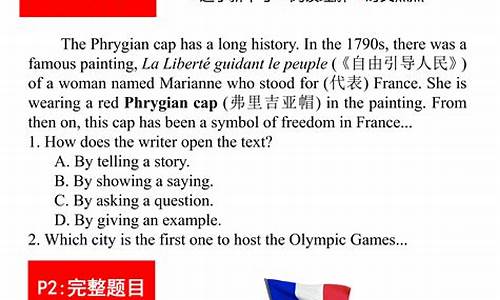奥运会吉祥物英语短文,奥运会吉祥物英语翻译

For a long time, China have already delivered a benedictory tradition through a sign.Each dolls of Olympic game mascot in Peking represent 1 to wish a wish finely:Prosper, merriment, intense emotion, health and good luck.The dolls take the great kindness of Peking, carrying toward wish each corner in the world, invite people in all countries to gather Peking totally, the huan celebrates the Olympics prosperous dian for 2008 years.
Blessing doll shell shell-Pisces blessing doll
The blessing doll shell shell represents Olympic five wreathses in of blue of one wreath. The wish of delivering is a prosperity.Its shape creativity comes from the our country traditional cultural art, the pattern of"fish" and"water" is the symbol of[with] prosperity and results, people use "the carp jump Dragon gate" implied meaning successful with dream of realization.Water mutually the shell shell of horoscope is a young girl with clean and pure gentleness, is a romantic bond maid naturally.Although she is very clever, also is the superior of aquatic sports.
Beijing has unveiled its five 2008 Olympic mascots the Five Friendlies to coincide with the 1,000-day countdown to the big event.
It is the first time in Olympic history that five mascots have been chosen.
Each mascot has a rhyming two-syllable name, the traditional way of expressing affection for children in China. Beibei is the Fish, Jingjing is the Panda, Huanhuan is the Olympic Flame, Yingying is the Tibetan Antelope and Nini is the Swallow.
The first characters of their two-syllable names read "Beijing Huanying Ni," or, in English, "Welcome to Beijing."
"The mascots are a special gift that Beijing presents to the world and to the Olympic Movement," said Liu Qi, president of the Beijing Organizing Committee for the Games of the XXIX Olympiad (BOCOG).
During a gala show on Friday evening, huge inflated cartoon figures of the mascots walked on stage amid a standing ovation from the audience in the Workers' Stadium.
The mascots, together with the official emblem and slogan of the 2008 Games, express Chinese people's wishes for peace, friendship, progress and harmony, Liu said.
The mascots have distinctive Chinese characteristics, representing not only the multi-ethnic cultures of China, but also the traditional Chinese philosophy of harmony between humans and nature, Liu noted.
Chosen in line with the colours of the Olympic Rings, they embody the landscape, dreams and aspirations of people from every part of China.
They also represent the five elements of nature the sea, forests, fire, earth and sky all stylistically rendered in ways that reflect the deep traditional influences of Chinese folk art and ornamentation.
"Five" also matches the five elements (metal, wood, water, fire and earth) believed by ancient Chinese people to explain the origins of the world.
Jacques Rogge, president of the International Olympic Committee (IOC), sent a congratulatory letter to the BOCOG saying China was "lucky to have so many beautiful animals to represent the Olympic spirit. I love them all. I believe that this little group of friends ... will be extremely popular and will help to spread Olympic messages throughout the world."
He added in the letter: "You've certainly touched my heart with your choices. And I'm sure the Five Friendlies will touch the heart of the world."
"The mascots are very cute and very creative," said Luo Yuan, an English teacher at Nanjing University of Technology in Jiangsu Province, East China.
"I like the yellow and red ones (the antelope and flame)," said Ning Chengzhe, a six-year-old pupil in Zhengzhou, the capital of Henan Province, Central China.
But Wang Bin, a bank employee in Beijing, said there were too many mascots and they were "hard to remember."
The "Five Friendlies" combine human and animal images. It is the first time an Olympic element, the Olympic flame, has been included in the mascots.
The 2000 Sydney Games featured three animal mascots Olly the Kookaburra, Syd the Platypus and Millie the Spiny Anteater.
The first mascot to appear at an Olympics was during the 1968 Winter Games in Grenoble, France, although Schuss the skier was not official. The first official mascot was Waldi the Dachshund, who appeared at the Munich Summer Games in 1972. Since then, the mascots have become a main element of the Olympic image. They have acted as a vehicle to convey the Olympic spirit to the general public, especially to children.
The "Five Friendlies" and other Olympic mascot merchandise will be on sale in authorized outlets in Beijing and other major Chinese cities.
"The launch of the mascot will bring sales of Olympic products to new heights," said Lai Ming, deputy director of the Marketing Department of BOCOG.
He believed the sales volume will be bigger than in previous Olympic Games.
Competition was hot with 662 entries, of which 611 were from the Chinese mainland, 12 from Hong Kong, Macao and Taiwan, and 39 from abroad. Many places wanted their local symbols picked as mascots.
China's western Qinghai Province pushed hard for the endangered Tibetan antelope, Fujian Province touted the South China tiger, Gansu favoured the mythical dragon and Jiangsu promoted the legendary Monkey King.(China Daily)